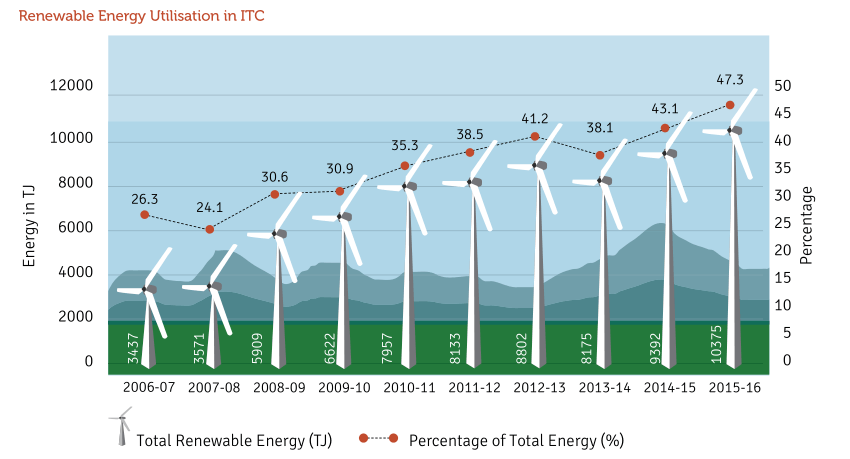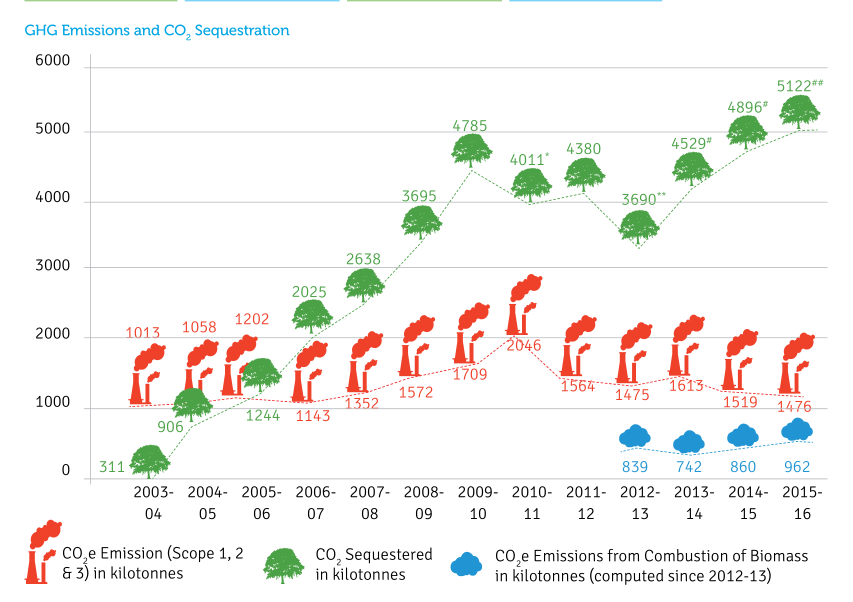ITC: $40B diversified Indian conglomerate at the forefront of climate change

How a $40B Diversified Indian Industrial conglomerate is at the forefront of dealing with climate change by being carbon positive, water positive and using 50% renewable energy.
ITC is one of India largest companies with a $40B market cap and leading positions in Fast-Moving Consumer Goods (FMCG), Hospitality and Paper[1]. India is the world’s third-largest emitter of greenhouse gases and recently committed via INDC to cut its greenhouse gas emissions per unit of GDP by about 35% by 2030 compared to 2005 levels[2].
Key Climate Change risks for ITC
Exhibit 1: Illustrative Climate Change risks by Business Sector according to the UN[3]
The most direct impact of climate change on ITC would be from the INDC commitments. This will result in future regulatory pressure around energy usage and gas emissions. There will also be effects around changing consumer preferences for sustainable products, water scarcity and the increased likelihood of extreme weather events. A second order effect will be the increased need for industrial companies like ITC to maintain a social license to operate[4]
Given this context, ITC has made several fundamental shifts in its business model to ensure it can deal with climate change and maintain a social license to operate.
Mitigation Strategies:
Low carbon growth path –50% renewable energy share by 2020: ITC was one of the early movers in the renewable energy space in India making a public statement about a goal of low carbon growth path. Renewable energy usage in the past 10 years has steadily climbed from 25% to 47.3% today – well on target to hit the goal of 50% by 2020[5].
Exhibit 2: Renewable energy utilization in ITC [5]
Carbon positive primarily through a social afforestation program:In order to ensure a supply of raw pulp for its paper division, ITC has built a unique wasteland development program which enables farmers who own wastelands to grow commercially viable pulpwood plantations . Today ITC’s Afforestation Program covers over 2,26,000 hectares and helped sequester 5,121 KT of CO2 – far above its emission levels.
This program has helped ITC stay Carbon positive for the last 11 years – one of the few companies to have such a robust track record.
Exhibit 3: GHG emissions in ITC [5]
Water positive: ITC is keenly aware of how water availability in a rain-fed nation like India is on a sharp downward slope and this could have catastrophic implications on its raw materials supply chain especially in the food business. Consequently, ITC has an integrated watershed management program – which has helped it say water positive for the last 14 years.
Organisation-wide focus on tracking and transparency:In keeping with the principle that one cannot track what is not measured accurately – there is a organization wide integrated sustainability data management system and ITC publishes an annual sustainability report. ITC limited is the only industrial Company in India to score a perfect 100 on Climate Disclosure Leadership Index (CDLI) disclosure requirements for sustainability[6]
Adaptation Strategy:
Preparation for adverse weather events: ITC is aware of the increased likelihood of extreme weather events disrupting its supply chain. Significant effort has been made on preparing ITC manufacturing units located in the coastal or river facing area for such events and Business continuity plans made to compensate any interruption of production from these facilities.
Going forward:
While ITC has done a good job of anticipating how climate change will affect its operations I believe in can do more from a internal perspective. Specifically
Technology innovation in its manufacturing operations: Most of the strategies that ITC has implemented so far are externally focused – by creating forest, watershed area etc. However, it seems little has been done by ITC to improve internal emission standards etc. On a specific note I think ITC could set targets for greenhouse gas emission reduction targets by business unit keeping in mind growth projections.
Adopt a “design to sustainability” approach[7]: Fundamentally, ITC is a manufacturing company and sells products that are consumed. No visible move has been made by ITC to make its packaging more sustainable. Perhaps, ITC could start using recycled material in its packaging or have incentives for recycling the paperboard they produce.
Create a chief sustainability officer position: ITC currently has a Board-approved Sustainability Policies with a Sustainability Compliance Review Committee to oversee it. I would recommend to create a strong signal and importantly bring this issue to the fore they create a Chief sustainability officer position that would be on the overall group management board to ensure a sustainability lens on all major decisions of the company.
What do you think about ITC’s approach to climate change?
Word count: 745 words
Sources
[1]http://www.itcportal.com/about-itc/profile/
[2]United Nations Global Compact, U. N. (2011). Adapting for a Green Economy. – https://www.unglobalcompact.org/docs/issues_doc/Environment/climate/C4C_Report_Adapting_for_Green_Economy.pdf
[3]http://www.wri.org/blog/2015/06/infographic-what-do-your-countrys-emissions-look
[4]Ernst & Young (2012). How should business approach carbon neutrality?. – http://www.ey.com/Publication/vwLUAssets/Carbon_neutrality/%24FILE/EY-carbon-neutrality.pdf
[5]ITC(2016). Sustainability Report – http://www.itcportal.com/sustainability/sustainability-report-2016/sustainability-report-2016.pdf
[6]CDP(2015). CDP Climate Change Report India Edition – https://www.cdp.net/en/reports/downloads/790
[7]Mckinsey(2015). How companies can adapt to climate change – http://www.mckinsey.com/business-functions/sustainability-and-resource-productivity/our-insights/how-companies-can-adapt-to-climate-change






Thank you for this great piece of analysis .
Do you think that ITC should also try focusing on making some of its products environment-friendly? For instance, have they made significant progress on making biodegradable detergents, smokeless cigarettes, etc.? Since their scale is so huge in India, making sustainable products alone will have a major impact on climate change.
Hey Hari, Fantastic blog post, I appreciated the insights on a company at the cutting edge of sustainability in an emerging market! Overall, I agree with your position and recommendations. For the sake of discussion, however, I want to kick the tires on the value of a “Chief Sustainability Officer.” While appointing a Chief Sustainability Officer would certainly be a strong signal externally, some (including myself) question the amount of change such company officers are typically able to drive (e.g. http://www.forbes.com/sites/stevedenning/2011/09/27/does-your-firm-need-a-chief-sustainability-officer/#30a5b07f4054). A cynical investor could interpret this as a PR move – particularly when such officers don’t have the decision authority to carry real “juice” on the board of directors. In the IKEA case for example, the Chief Sustainability Officer had a team of 22, out of an employee base of 135,000. If this person gets into an argument with even a more “junior” business unit head, they may simply not have the organizational clout to win.
Rather, I would lean heavily into your first recommendation, “technology innovation in manufacturing operations.” As a diversified conglomerate I am sure there are opportunities abound to simultaneously embrace sustainable practices and cut costs (e.g. local sourcing). By identifying these targets and creating opportunities, I feel ITC can bake sustainability more deeply into its actual operations.
Again awesome job on the post!
Thank you for the very insightful article. I had not heard about ITC before, and it’s great to see companies in emerging markets demonstrate such initiative.
Doing some quick research on ITC (Indian Tobacco Company), my understanding is that around 60% of its revenues still come from cigarettes, as it controls 80% of the Indian cigarette market. As growing tobacco for consecutive years in the same place can strip the land of vital nutrients, I am curious if ITC has a similar solution to its afforestation initiative in this regard, and if it works with farmers to ensure crop rotation and promoting sustainable and climate-resilient farming practices.
Nevertheless, regardless of the motivation behind it, I applaud ITC’s initiatives and its role in setting an example in environmental consciousness for other Indian companies and for other companies around the world.
Hari! This is awesome. I particularly enjoyed the use of visuals in your post.
Since this has worked so well for ITC in India, are there any large-scale companies in the US (likely not quite as large) that you think could be setup this way and still perform well fiscally? I’m not sure how similar of a company there is in the states, but am curious how we can have more companies follow this model and consequently have more charts looking like exhibit 3!